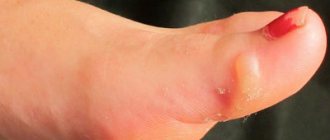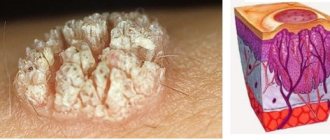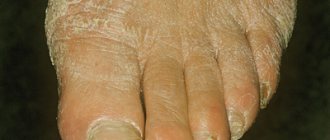In general, in the surgical community there is little talk about calluses and their treatment. Another thing: talk about methods of gastric resection and techniques for suturing the duodenal stump! It's true! And here's something small. Go to the bathhouse, take a steam bath, take a pumice stone, wipe off the callus and everything will go away. But no... It won’t always help.
Calluses are commonly called characteristic changes in the area of skin friction. The skin adapts to prolonged physical exposure, the epidermis becomes thicker. This is a normal physiological process. It is worth working in the country with a hammer for several days to see characteristic thickenings on the palms. This is how the skin adapts. Most of all, it is prone to such protective keratinization of the skin in the area of the soles. And in principle this is obvious. In the distant past, our ancestors did not know shoes, and modern people absolutely cannot imagine walking barefoot, say, through a forest or field. However, as studies have shown, two weeks are enough for the skin on the feet to become rough and walking barefoot will be quite comfortable and not painful.
Possible causes
Calluses appear between the toes very quickly.
In hot summer weather, literally after several hours of walking barefoot or in uncomfortable sandals, you can feel discomfort, most often in the space between the 4th and 5th toes. In this case, the appearance of watery blisters in the interdigital folds is observed (as in the photo on the right). Further irritation of the damaged area leads to its transformation into a dry callus, which without treatment can turn into a core callus. Calluses between the toes occur for almost the same reasons as in other places on the foot. Most often it appears:
- as a result of wearing uncomfortable shoes with narrowed or, conversely, overly wide toes, as well as too high heels;
- in the presence of curved phalanges of the fingers or protruding bone growths;
- if you have flat feet;
- for arthrosis, arthritis, gout and other diseases of the foot joints;
- in people who are overweight;
- in case of excessive sweating of the feet.
Since the skin in the areas between the toes is too vulnerable, the formation of calluses in these areas causes discomfort and pain, which causes difficulty in walking. Pathogenic bacteria can easily penetrate microcracks that appear on the surface of calluses. In combination with excessive humidity, good conditions are created for the development of the inflammatory process. Doctors recommend getting rid of even those calluses that do not cause any particular inconvenience.
Preventive measures
To ensure that calluses never bother you again, you need to adhere to the following recommendations:
- carefully monitor foot hygiene;
- use softening ointments, gels, creams, make foot baths;
- give up uncomfortable and low-quality shoes;
- limit wearing high-heeled shoes;
- at the first symptoms of callus formation, immediately begin treatment;
- Do not allow shoe insoles to become thin or curled.
Types of calluses
Depending on the speed of the process of formation of calluses, there are two types: soft and dry. Popularly, soft calluses are called dropsy. Their distinctive feature is their very rapid appearance as a result of skin friction. Their appearance resembles a bubble, inside of which there is a clear tissue liquid, in some cases mixed with blood. They are very painful, but generally do not require treatment - they heal on their own within a few days. It is advisable to apply a patch with a sterile pad to such a callus on the foot. A burst bubble should be treated with an antiseptic.
Dry calluses take longer to form. It is the result of constant rubbing or squeezing of the skin. The epidermis thickens. In accordance with this, flat and disc-shaped calluses are distinguished. If they are flat, there are no unpleasant sensations, and removing them is quite simple.
The big problem is a callus between the toes with a shaft. They themselves are very painful, and getting rid of them on your own is not easy, since they are located quite inconveniently. In addition, when removing the rod, the thin skin around them can be damaged. Most often they form between the fourth finger and the little finger. This is explained by the fact that the little toe is most often damaged by uncomfortable shoes, since it is the most mobile.
Lumps in the area of the first metatarsophalangeal joint, formed by osteophytes.
Hallux valgus
| A. Appearance of the foot | b. corns on the sole of the foot | |
This is the most common cause of a lump. It is accompanied by drooping of the arches of the feet. A bunion with hallux valgus has the following features:
- hard, immobile, increases in size slowly;
- a rapid increase in the size of the bone is associated with the development of bursitis;
- located at the base of the first finger;
- the first finger is deviated outward;
- Calluses (corns) may form on the sole of the foot;
- Deformation of the 2nd finger is often observed.
Arthrosis of the first metatarsophalangeal joint
Bone growths form along the perimeter of the articular surfaces of the first metatarsal bone and the base of the proximal phalanx of the first finger.
- the “bone” is formed mostly in the area of the head of the first metatarsal bone on the back of the foot, but osteophytes can be along the entire perimeter of the joint;
- The first metatarsophalangeal joint is mainly deformed in isolation.
- first of all, movements in the joint are limited, and in the future they may be completely absent;
- patients feel severe pain, which becomes constant over time.
| A. side view of the foot | b. top view of the foot |
| V. x-ray of the foot | d. joint changes |
| “Lump” with arthrosis of the metatarsophalangeal joint | |
How to treat a soft callus
At the first manifestations of discomfort resulting from the formation of a callus between the toes, treatment should be started immediately so as not to worsen the situation.
First you need to get rid of the cause that led to the painful formation. It is most likely tight shoes. If your life situation does not allow you to do this immediately, then to reduce skin irritation you should apply a napkin or a clean piece of cloth to the affected area. Next, the soft callus between the toes is treated by cleansing its surface with warm water and gluing a special callus or bactericidal adhesive plaster to the affected area of the skin. Opening the blister is not recommended because there is a risk of infection. Over time, it will dry out on its own, and only in special situations, such as suppuration, should the bubble be removed. However, this must be done by a qualified doctor in a clinic.
If the blister bursts and a wound forms in its place, it must be treated with an antiseptic or a remedy for wet calluses. You can also purchase special ointments at the pharmacy that will have a comprehensive effect on the diseased area, since they contain antibacterial substances that enhance skin regeneration. If the lump increases in size, turns red and begins to manifest as throbbing or sharp pain, this means that an inflammatory process has begun. It is not recommended to treat it yourself - doctors at the clinic will help solve the problem quickly and painlessly.
When should you contact a specialist?
If all folk and home methods of therapy do not give the desired result, then you need to consult a specialist. The problem of calluses is dealt with by cosmetologists, dermatologists, surgeons and podologists .
Only an experienced doctor can help solve the problem without consequences. He will disinfect the growth and prescribe you the necessary therapeutic course.
If the growth contains pus, a course of antibiotic treatment may be necessary.
If the infection is serious, the doctor will prescribe medications to the patient for oral administration, as well as means for external treatment of the defect (in the form of ointments, creams, gels, etc.).
Dry calluses between the fingers can seriously complicate a person’s life. So there is no point in postponing treatment for such a problem, especially since delay can lead to the formation of complications in the form of rod growths. And this means additional expenses for hardware treatment.
Treatment of dry callus
Dry callus is a hard keratinized skin.
To prevent it from penetrating deep into the skin, when it is detected, treatment must be started immediately. Under no circumstances should you get rid of a callus by cutting it off yourself mechanically, since the skin in these places is too delicate and there is a possibility of infection. Dry callus can be removed comprehensively using special baths and keratolytic preparations containing salicylic acid, which can be easily purchased at the pharmacy. Treating dry calluses between the toes with baths is the simplest and most effective way. It works like this:
- first you need to steam your leg well - this will take at least half an hour;
- then the soft skin must be thoroughly treated with pumice, getting rid of keratinized areas;
- after this, apply a small amount of keratolytic ointment to the affected area of the skin and apply a protective bandage to the leg. You can use special callus plasters, having previously purchased them at the pharmacy.
It is worth noting that all anti-callus agents act on the principle of softening the keratinized areas, which makes it easy to get rid of them in the future. Therefore, patches and ointments should be left on areas with calluses for 1-2 days.
What is not recommended to do
If you are going to remove the callus yourself, then you should not do the following:
- try to cut off a callus that is not softened, especially if it has a core;
- When using salicylic acid or vinegar, you should not apply these products to healthy areas of the skin;
- It is not recommended to use more than one removal method for one callus.
Important! If you are in doubt about which treatment option to choose, seek advice from a dermatologist.
Treatment of core calluses between the toes
Those who did not pay attention to dry calluses immediately after they appeared, subsequently very often wonder how to cure a callus between the toes with a core. After all, this type is an advanced form of dry callus, inside of which a “root” has formed that goes deep into the skin. This is a very unpleasant formation, since it is characterized by severe pain, as with the appearance of a spur, especially if the rod has penetrated to the level where the nerve endings are located.
How to remove this type of callus and can it be done at home? The callus can be removed independently, but only if it is not too deep. However, a positive result cannot always be achieved. The best option for deciding what to do in such cases is to turn to professionals. For this purpose, the medical institution uses:
- Laser burning.
- Freezing using liquid nitrogen.
- Mechanical drilling.
People prone to the appearance of interdigital formations should immediately take measures to eliminate them. After all, in the early stages you can get rid of the callus yourself. But solving the problem of advanced cases will require much more time, effort and money.
Callus between toes: prevalence, risk factors
The appearance of such a defect as a callus between the toes is greatly facilitated by an uncomfortable shoe model, too narrow a toe, a high heel, the presence of rough internal seams, as well as an incorrectly selected size, which leads to the formation of folds on the socks. In this regard, calluses between the toes are typical for people involved in ballet and figure skating, where the use of special, definitely hard shoes is expected.
However, podologist Mikula N.V. notes that the number of people who are forced to deal with uncomfortable shoes and ill-fitting lasts in everyday life is also huge. Poor-quality shoe material can also provoke the development of these defects, because increased humidity due to sweating of the feet is also considered an unfavorable prerequisite. Examples of unsuitable shoes include models that are made using synthetic, poorly ventilated materials that cause skin irritation. At the same time, the development of corns and calluses is also facilitated by such prerequisites as:
- Increased physical activity on the feet, long running or walking;
- Large body weight, carrying heavy objects.
A tendency to keratinization of the skin is also observed in the case of medical problems. The development of pathology is promoted by:
- Joint damage, arthrosis, rheumatoid arthritis, gout;
- Orthopedic disorders, flat feet;
- Psoriasis;
- Diabetes;
- Somatic disorders occurring with swelling of the legs;
- Vitamin deficiency, insufficient intake of vitamins B and A into the body;
- Hyperhidrosis, increased sweating.
Soft callus between toes
Calluses located between the toes are of two types: wet or dry. Wet calluses, or dropsies, usually appear in the summer. They represent an area where the skin has peeled off, and a clear liquid has accumulated underneath it, in some cases bloody. If such a blister bursts, fluid flows out of the wound, exposing an erosive surface that is painful to the touch. Given the fairly large area of the lesion and the impossibility of refusing to regularly wear shoes, there is a high probability of infection.
To prevent the opening of dropsy and not further injure the resulting pathological focus, podologist Mikula N.V. recommends changing your shoe model. If the blister does burst, wash your feet in a soapy solution and wipe dry. Antiseptic ointment is applied to the wound surface. It is not recommended to treat the wound with a solution of iodine or brilliant green, as there is a risk of burns and additional injury to the skin. To prevent infection, an antibacterial patch is applied to the area of the exposed callus.
With proper care, consultation with a specialist is not required. You should consult a doctor only if pain increases, signs of inflammation, or redness appear. It would be a good idea to use the services of a professional if the callus re-forms in the same place. Doctor Mikula N.V. will help you more thoroughly study the causes of the problem and prescribe the necessary treatment measures.
Dry calluses between fingers
Dry types of calluses include corns and core calluses. The first ones appear with constant friction and prolonged pressure. The skin in the area begins to harden, rising above the healthy areas. It takes on a yellowish tint. Corns do not cause pain. Usually they manifest themselves only as a cosmetic defect, but if left untreated they can be accompanied by the formation of painful cracks and, as a result, become infected.
Treatment of corns between the fingers involves softening the stratum corneum. To do this, baths with exfoliating agents are used at home, and external pharmaceutical preparations are used. When applied to the skin, they soften it, dissolve the horny cells of the epidermis, and in addition, have an antiseptic effect. Keratolytics are applied pointwise to the damaged tissue, and a regular patch is used to protect healthy skin. They are left on the damaged area for a day. After completion of the exposure, it is intended to eliminate the softened areas by scrubbing, removing the affected tissue with a pumice stone.
In their form, external remedies for the treatment of corns between the fingers can be in the form of ointments , gels, or solutions. According to people's reviews, the best ointment for treating corns between the fingers will be one that contains components such as salicylic, benzoic and lactic acid, and urea. When choosing a product, you should pay attention to the concentration of active ingredients.
Calluses are hard, rough patches of skin with a dark spot in the center. They do not have a cavity, but are distinguished by the presence of a rod that extends deep into the thickness of the epidermis. If you have a callus, you will not be able to avoid constant pain.
Treatment of dry calluses with a core is more difficult. In the case of such a callus between the fingers, it is not possible to soften it even with the help of the most effective external means, since the hardened core lies deep in the tissues. In most cases, a patch or ointment for treating corns between the toes will not have the desired effect. To provide real help to the patient, surgical intervention is necessary. The following methods are used as a basis:
- Excision of this pathological formation using surgical instruments. Surgical treatment of dry calluses with a core is an intervention carried out in accordance with the same conditions as any other surgical procedure: local anesthesia is used, the principles of asepsis and antisepsis are observed. During the operation, the superficial part of the callus is first excised, then an additional incision is made deeper. Through it, the rod is captured by a clamp and removed.
This procedure is easier than in the heel area, since the size of the rod is significantly smaller, but it will not be possible to do without dressings.
- Removing calluses with liquid nitrogen is a technique that is used less and less, since the effect involves several sessions and a fairly long rehabilitation period. At the same time, the sensations during the procedure are characterized as insufficiently comfortable.
- Laser callus removal is the most modern technology. A short-term exposure of the callus area to a beam of photon radiation leads to its evaporation. Considering the hemostatic, bactericidal effect of the laser, a significant advantage of the technique compared to surgical treatment is rapid healing, reducing the risk of infection and the development of complications.
At the same time, Doctor Mikula N.V. I completely agree with the opinion of my colleagues that it is very dangerous to remove calluses with a core at home. The lack of the necessary theoretical training and skills will inevitably lead to injury to the deep layers of the epidermis and infection. In addition, when planning the procedure, it is important to determine that it is a callus and not a plantar wart. Improperly performed mechanical action can provoke the spread of the virus and the appearance of new formations.
Treatment of calluses between the fingers with podiatrist Mikula Natalia Valerievna in Moscow
Treatment for corns between the toes depends on their type and severity. Podologist Mikula N.V. refers to the following methods as methods of influence:
- Drug therapy using agents that have keratolytic properties, that is, capable of softening rough skin. The specialist will select the drug that will be most effective under these clinical conditions. At the same time, an integrated approach to eliminating pathological signs and excluding relapses will be developed.
- As a method of removing calluses, you can use the option of grinding them off with a special cutter - hardware pedicure. Thanks to a wide range of attachments and operating modes of the equipment, and the skill of a specialist, it is possible to remove only altered areas without injuring healthy tissue. An important stage of this procedure is thorough antiseptic treatment. Other advantages include a comfortable feeling, no rehabilitation, and an affordable price. However, resorting to a hardware pedicure requires several sessions, since by excessively removing thickened tissue in one approach, one can expect increased cell regeneration and rapid relapse.
By contacting a specialist of such a high level as Mikula N.V., you can be sure that the doctor will reliably find out the causes of corns between the toes and competently prescribe treatment . For this pathology, it must necessarily include an impact on the causative factor. Otherwise, over time there is a high probability of a relapse.
By making an appointment with podologist Mikula N.V., you can count on the doctor to carefully study all the prerequisites. If the provoking factor is incorrectly selected shoes or orthopedic disorders, special callus pads can be used as an effective technology, with the help of which it will be possible to more correctly distribute the load on the foot. The specialist will also select special insoles, arch supports, and other orthopedic devices. It will be possible to discuss with your doctor other nuances of prevention.
Help from traditional medicine
There are many ways to get rid of calluses between your toes, using the advice of traditional medicine.
For the most part, they help in the treatment of dry calluses. After all, to remove soft ones, calluses, antibacterial adhesive plaster and some kind of antiseptic are used. Treatment with folk remedies involves the use of:
- warm baths. Regardless of what components are included in the solution used, its main purpose is to stimulate the detachment of hard areas. When taking such baths, boric acid, laundry soap, potassium permanganate, vinegar, soda, table or sea salt are most often added to the water;
- compresses. When using them, it is important not to overdo it, so as not to cause allergies or any irritation. After all, many compress recipes contain aggressive substances - lemon peel, acetic or citric acid, tomato juice, garlic, onion, etc. To achieve peeling of dead skin, you can use a compress soaked in potato juice or diluted propolis.
It is very important to help the treated area of skin recover after getting rid of the callus. To do this, you can use nourishing masks or vegetable oil. If the area where the removed callus was located begins to bleed and swell, it is imperative to treat it with a healing antibacterial agent. Despite the fact that there are a huge number of medications and folk remedies for treating painful interdigital formations, it is best to try to prevent their occurrence.
Bumps on 2-4 toes
Bunions on the 2nd to 4th toes are the result of hammertoes, claw toes, and mallet toes. Distinctive features:
- it is always formed by the head of the proximal or distal phalanx of the finger and bone growths. Sometimes the volume of the “bone” increases due to inflammation of the soft tissues;
- it is always located on the dorsum of the finger in the area of the proximal or distal interphalangeal joints;
| Hammertoe deformity, top and side view of the foot |
Hygroma of the foot
Hygroma is a “hernia” of the joint capsule or tendon sheath. A bulge can form on the dorsum of the foot from the ankle to the toes.
Features of hygroma on the foot:
- Forms on the dorsum of the foot. Hygromas on the plantar surface of the foot are rather an exception.
- At the beginning of its occurrence, it periodically appears and disappears, then becomes constant.
- Painless, dense or soft-elastic consistency, often mobile.
- When rubbing with shoes, signs of inflammation may appear: redness, pain, swelling.
- When wearing tight shoes it causes discomfort and pain.
| Appearance of the foot with hygromas |
How to cure dry and root types?
Root callus is considered a type of dry callus, but it is much more difficult to remove. If the callus is dry, just steam your foot and apply a compress of ointment and salicylic acid.
After a few sessions, the dead skin can be removed. You won’t be able to remove root callus on your own. It has a rod that penetrates into the deep layers of the skin. Therefore, it is better to get rid of this neoplasm in a cosmetologist’s office.











